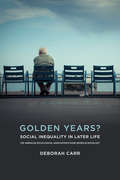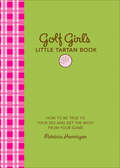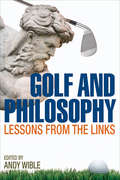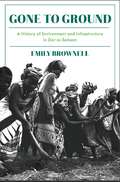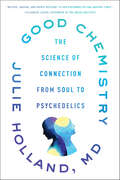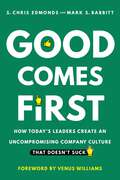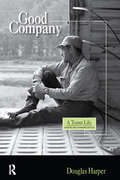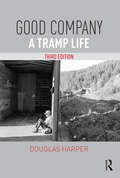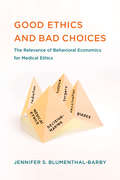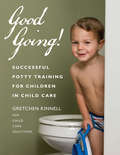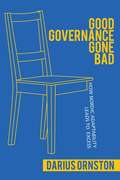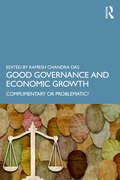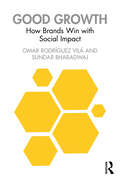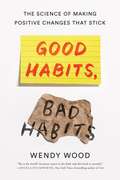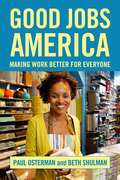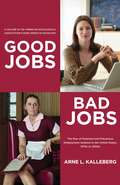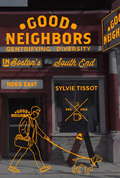- Table View
- List View
Golden Gulag: Prisons, Surplus, Crisis, and Opposition in Globalizing California (American Crossroads #21)
by Ruth Wilson GilmoreSince 1980, the number of people in U.S. prisons has increased more than 450%. Despite a crime rate that has been falling steadily for decades, California has led the way in this explosion, with what a state analyst called "the biggest prison building project in the history of the world." Golden Gulag provides the first detailed explanation for that buildup by looking at how political and economic forces, ranging from global to local, conjoined to produce the prison boom. In an informed and impassioned account, Ruth Wilson Gilmore examines this issue through statewide, rural, and urban perspectives to explain how the expansion developed from surpluses of finance capital, labor, land, and state capacity. Detailing crises that hit California's economy with particular ferocity, she argues that defeats of radical struggles, weakening of labor, and shifting patterns of capital investment have been key conditions for prison growth. The results--a vast and expensive prison system, a huge number of incarcerated young people of color, and the increase in punitive justice such as the "three strikes" law--pose profound and troubling questions for the future of California, the United States, and the world. Golden Gulag provides a rich context for this complex dilemma, and at the same time challenges many cherished assumptions about who benefits and who suffers from the state's commitment to prison expansion.
Golden Years?: Social Inequality in Later Life (American Sociological Association's Rose Series)
by Deborah CarrThanks to advances in technology, medicine, Social Security, and Medicare, old age for many Americans is characterized by comfortable retirement, good health, and fulfilling relationships. But there are also millions of people over 65 who struggle with poverty, chronic illness, unsafe housing, social isolation, and mistreatment by their caretakers. What accounts for these disparities among older adults? Sociologist Deborah Carr’s Golden Years? draws insights from multiple disciplines to illuminate the complex ways that socioeconomic status, race, and gender shape the nearly every aspect of older adults’ lives. By focusing on an often-invisible group of vulnerable elders, Golden Years? reveals that disadvantages accumulate across the life course and can diminish the well-being of many. Carr connects research in sociology, psychology, epidemiology, gerontology, and other fields to explore the well-being of older adults. On many indicators of physical health, such as propensity for heart disease or cancer, black seniors fare worse than whites due to lifetimes of exposure to stressors such as economic hardships and racial discrimination and diminished access to health care. In terms of mental health, Carr finds that older women are at higher risk of depression and anxiety than men, yet older men are especially vulnerable to suicide, a result of complex factors including the rigid masculinity expectations placed on this generation of men. Carr finds that older adults’ physical and mental health are also closely associated with their social networks and the neighborhoods in which they live. Even though strong relationships with spouses, families, and friends can moderate some of the health declines associated with aging, women—and especially women of color—are more likely than men to live alone and often cannot afford home health care services, a combination that can be isolating and even fatal. Finally, social inequalities affect the process of dying itself, with white and affluent seniors in a better position to convey their end-of-life preferences and use hospice or palliative care than their disadvantaged peers. Carr cautions that rising economic inequality, the lingering impact of the Great Recession, and escalating rates of obesity and opioid addiction, among other factors, may contribute to even greater disparities between the haves and the have-nots in future cohorts of older adults. She concludes that policies, such as income supplements for the poorest older adults, expanded paid family leave, and universal health care could ameliorate or even reverse some disparities. A comprehensive analysis of the causes and consequences of later-life inequalities, Golden Years? demonstrates the importance of increased awareness, strong public initiatives, and creative community-based programs in ensuring that all Americans have an opportunity to age well.
Golf Girl's Little Tartan Book: How to Be True to Your Sex and Get the Most from Your Game
by Patricia HanniganPlay like a girl! A female golf writer offers tips, inspiration, and laughs for women who want to excel at the sport. Golf blogger Patricia Hannigan has a driving ambition: to get each of her thousands of female followers to play like a girl. That, she insists, is just the way for a woman to excel at golf—and, every bit as important, to have a lot of fun doing so. A witty and wise departure from oh-so-predictable instructional guides, Golf Girl&’s Little Tartan Book doesn&’t focus only on technique. Hannigan also writes about attitude and the mental game, demonstrating how a gal who&’s passionate about golf can use her womanly style to her distinct advantage on the course. From teeing off (don&’t be coy about using those red tees) to getting teed off (don&’t be timid about throwing the occasional tantrum), Hannigan entertainingly dispenses advice that&’s sure to be useful to any woman intent on securing membership in the &“boys&’ club&” called golf.
Golf University: Become a Better Putter, Driver, and More—the Smart Way
by Scott WeemsIn Golf University, Scott Weems offers comprehensive advice to excelling on the golf course that takes readers beyond traditional tips on putting and driving. Divided into four “semesters,” this book incorporates the disciplines of physics, math, medicine, sociology, geology, economics, and more to help golfers maximize their success and have the most fun. Some of the many lessons that Weems offers include: Achieving maximum efficiency in the golf swing, meaning no loss of kinetic energy from club to ball, would require a driver 72 feet long. And a club the same weight as the ball. Twelve percent of business executives rate golf as more important than sex. Players shot half a stroke higher when paired with Tiger Woods in his prime. The effect was even worse on the final day of competition. Putting against the direction of the grain (i.e., opposite the most recent mowing) leaves the ball 15 percent shorter than putting in the opposite direction. Closing your eyes occasionally while putting will leave your ball almost 10 percent closer to the pin. And more! Golf University uses a mixture of research, interviews, and Weems’s own experiences as a scientist and golfer to introduce readers to the latest discoveries in the sport.
Golf and Philosophy: Lessons from the Links (The Philosophy of Popular Culture)
by Andy WibleReflections on the game and getting through life&’s hazards and roughs. In a game where players are expected to call their own penalties and scoring the least points leads to victory, decorum takes precedence over showmanship and philosophical questions become par for the course. Few other sports are as suited for ethical and metaphysical examination as golf. It is a game defined by dichotomies—relaxing, yet frustrating, social, yet solitary—and between these extremes there is room for much philosophical inquiry. In Golf and Philosophy: Lessons from the Links, a clubhouse full of skilled contributors tee off on a range of philosophical topics within the framework of the fairway. The book&’s chapters are arranged in the style of an eighteen-hole golf course, with the front nine exploring ethical matters of rationality and social civility in a world of moral hazards and roughs. The back nine pries even deeper, slicing into matters of the metaphysical, including chapters on mysticism, idealism, identity, and meaning. Taken together, the collection examines the intellectual nature of this beloved pastime, considering the many nuances of a sport that requires high levels of concentration, patience, and consistency, as well as upstanding character. Golf and Philosophy celebrates the joys and complexities of the game, demonstrating that golf has much to teach both its spectators and participants about modern life. &“Any volume built on the premise that if Aristotle and Plato were still here they&’d likely be ardent golfers is apt to tickle a few brain cells.&” ―Golf Magazine
Gone to Ground: A History Of Environment And Infrastructure In Dar Es Salaam
by Emily BrownellGone to Ground is an investigation into the material and political forces that transformed the cityscape of Dar es Salaam, Tanzania in the 1970s and early 1980s. It is both the story of a particular city and the history of a global moment of massive urban transformation from the perspective of those at the center of this shift. Built around an archive of newspapers, oral history interviews, planning documents, and a broad compendium of development reports, Emily Brownell writes about how urbanites navigated the state’s anti-urban planning policies along with the city’s fracturing infrastructures and profound shortages of staple goods to shape Dar’s environment. They did so most frequently by “going to ground” in the urban periphery, orienting their lives to the city’s outskirts where they could plant small farms, find building materials, produce charcoal, and escape the state’s policing of urban space. Taking seriously as historical subject the daily hurdles of families to find housing, food, transportation, and space in the city, these quotidian concerns are drawn into conversation with broader national and transnational anxieties about the oil crisis, resource shortages, infrastructure, and African socialism. In bringing these concerns together into the same frame*, Gone to Ground* considers how the material and political anxieties of the era were made manifest in debates about building materials, imported technologies, urban agriculture, energy use, and who defines living and laboring in the city.
Good Catholics
by Patricia MillerGood Catholics tells the story of the remarkable individuals who have engaged in a nearly fifty-year struggle to assert the moral legitimacy of a pro-choice position in the Catholic Church, as well as the concurrent efforts of the Catholic hierarchy to suppress abortion dissent and to translate Catholic doctrine on sexuality into law. Miller recounts a dramatic but largely untold history of protest and persecution, which demonstrates the profound and surprising influence that the conflict over abortion in the Catholic Church has had not only on the church but also on the very fabric of U.S. politics. Good Catholics addresses many of today's hot-button questions about the separation of church and state, including what concessions society should make in public policy to matters of religious doctrine, such as the Catholic ban on contraception.
Good Chemistry: The Science of Connection, from Soul to Psychedelics
by Julie HollandA psychiatrist and psychedelic researcher explores the science of connection—why we need it, how we’ve lost it, and how we might find it again.We are suffering from an epidemic of disconnection that antidepressants and social media can’t fix. This state of isolation puts us in “fight or flight mode,” deranging sleep, metabolism and libido. What’s worse, we’re paranoid of others. This kill-or-be-killed framework is not a way to live. But, when we feel safe and loved, we can rest, digest, and repair. We can heal. And it is only in this state of belonging that we can open up to connection with others.In this powerful book, Holland helps us to understand the science of connection as revealed in human experiences from the spiritual to the psychedelic. The key is oxytocin—a neurotransmitter and hormone produced in our bodies that allows us to trust and bond. It fosters attachment between mothers and infants, romantic partners, friends, and even with our pets. There are many ways to reach this state of mental and physical wellbeing that modern medicine has overlooked. The implications for our happiness and health are profound. We can find oneness in meditation, in community, or in awe at the beauty around us. Another option: psychedelic medicines that can catalyze a connection with the self, with nature, or the cosmos. Good Chemistry points us on the right path to forging true and deeper attachments with our own souls, to one another, and even to our planet, helping us heal ourselves and our world.
Good Comes First: How Today's Leaders Create an Uncompromising Company Culture That Doesn't Suck
by S. Chris Edmonds Mark S. BabbittDiscover the practical, step-by-step guide to creating a workplace culture that&’s better for employees, customers, and stakeholders—and your company&’s bottom line. For decades, talented people have tolerated old-school leaders who put results before respect, toxic company cultures, and workplaces that suck. But those days are over, and if leaders want to attract and retain the best employees—while improving productivity, customer service, employee satisfaction, and profits—it&’s time for them to create work cultures where good comes first. The problem is that because the corporate world has too often been driven primarily by results, we seldom ask leaders to change their work cultures. Even if we did, most leaders don&’t know how. This book provides the actionable inspiration and practical direction needed to make that change happen. In Good Comes First, S. Chris Edmonds and Mark S. Babbitt go beyond theoretical advice, using their combined 50 years of experience to present proven strategies for creating purposeful, positive and productive work cultures. Cultures where good comes first for employees, customers, leaders, and stakeholders—and where improved business outcomes quickly follow. In these pages, readers will learn to: Appreciate why a good comes first culture is a business imperative – especially for younger generations. Distance yourself from the competition that maintains its undefined work culture (one that most likely sucks). Identify what &“good&” means for your company in today&’s business climate – and in the future of work. Define your uncompromising work culture as you build a foundation of respect AND results. Formalize your team&’s servant purpose so that everyone understands how what your team does improves lives and communities. Specify respectful behaviors, so your desired values are observable, tangible, and measurable. Align your entire organization to your desired work culture – where good comes first every day. Assess the quality of your current work culture by measuring and monitoring how well your leaders and your executive team demonstrate your servant purpose, valued behaviors, strategies, and goals. Hold everyone accountable for both respect and results through modeling, celebrating, measuring, coaching, and mentoring leaders and team members. Implement real, needed change – and quit &“thinking&” and &“talking&” about change (but never really get change started). Become a change champion while creating a lasting legacy as a business leader. Build a team of good people doing good work in a good company. What&’s more, Good Comes First shows you where potential barriers to success hide—and how to push through them—and illuminates the moments when you&’ll feel the most satisfaction and gain the most traction. After reading this book, you will see that when done right, change is not only possible—it&’s practical, powerful, and profitable. And you will realize that you are the right person, at the right time, to make that change happen.
Good Company
by Douglas HarperGood Company: A Tramp Life, is a vivid portrait of a lifestyle long part of America's history, yet rapidly disappearing. The author traveled extensively by freight train to gain rich insights into the elusive world of the tramp. Richly illustrated with 85 photographs by the author, the book presents the homeless man as an individual who "drank, migrated, and worked at day labor" rather than the stereotype of a victim of alcoholism. The tramps with whom Harper shared boxcars and hobo jungles were the labor force that harvested the crops in most of the apple orchards in the Pacific Northwest. They were drawn to the harvest from across the United States and migrated primarily on freight trains, as had hobos in the 1930s. Although not without its problems, the tramp way of life is a fierce and independent culture that has been an integral part of our American identity and an important part of our agricultural economy. Since the first edition of this classic book was published by the University of Chicago Press, the tramp has virtually disappeared from the American social landscape. The agricultural labor force is now made up of Hispanic migrants. This significantly revised and updated edition contrasts this disappearing lifestyle with the homelessness of the modern era, which has been produced by different economic and sociological forces, all of which have worked against the continuation of the tramp as a social species. The new edition richly documents the transition in our society from "tramps" to urban homelessness and the many social, political, and policy changes attendant to this transformation. It also includes an additional thirty-five previously unpublished photographs from the original research.
Good Company: A Tramp Life
by Douglas HarperThis sociological classic shows how the railroad tramp’s status as a deviant changed from frontier itinerant to post settlement vagrant; from class conscious proletariat in the Depression to the damaged post WWII vet. The third edition (with new photos) discusses how today the freights have become the milieu of violent gangs who transport drugs, human traffickers, and serial killers. Beating the odds against increased post 9/11 surveillance are yuppie adventure seekers, young travelers, crust punks and oogles. In the background is the same freight train—unforgiving and lethal—and cultures policed at times by honorable tramps and at times by sadistic enforcers of violent gangs.? Features of the new edition: Eight previously unpublished photos that reflect new directions in visual ethnography. (90 photos altogether) A fuller integration of photos made during the author’s participant research with tramps over thousands of miles on the freights and while living homeless in urban America. New, nuanced edit of a narrative describing author’s five week immersion with the quintessential tramp of the era, Carl.
Good Dividends: Responsible Leadership of Business Purpose (Routledge Studies in Leadership Research)
by Ken Parry Thomas Maak Steve KempsterThis book seeks to answer the question of ‘leadership for what?’. We shall outline an answer by focusing on responsible leadership of purpose through an inter-disciplinary perspective. Responsible leadership moves the axis of leadership from leader-followers to leader-stakeholders; away from looking at leadership as person-centric – the qualities, abilities, and effectiveness of the leader, to a focus on the purposes, responsibilities and activities of leadership. Leadership orientation is about realising value for a range of constituencies, not just the shareholders of the business. In this way this book offers up an alternative business model to that of dominant neo-liberal approaches to capitalism and its flow-on effect to the leadership project. This is a model that draws on a most obvious assumption – if leaders maximise the use of all the capitals of their business they will maximise their dividends, and thus deliver their responsibility to the shareholders as well as other relevant stakeholders. This book explores how five dividends (based on five capitals) can be developed through attention to a sixth dividend (and sixth capital) – the dividend from our planet and communities. The planetary dividend is the flourishing of humanity – but it is also a significant dividend to the business. For example, by engaging the business in a purpose-led orientation to enhance the planetary dividend, the dividend from human resourcefulness becomes manifest – employee sense of purpose, commitment, passion and energy. The realisation of such can also connect with dividends from innovation, operations and brands. For example, the business benefits from a purpose-driven brand. In short, responsible leadership of purpose outlines a case for leadership to focus on a connected portfolio of ‘good’ dividends as an answer to the question ‘leadership for what?’ The book is written by academics and organisational leaders. It draws on a range of research with leaders from a variety of contexts to illustrate the challenges but also the benefits of this argument. It is an ambitious book: ambitious, in terms of moving leadership towards realising purpose; ambitious by seeking to align a range of business disciplines around responsible leadership; and ambitious because it challenges the dominant assumptions that shape business leadership. However, it is based on a simple question: why would a business not wish to generate good dividends for all its stakeholders?
Good Ethics and Bad Choices: The Relevance of Behavioral Economics for Medical Ethics (Basic Bioethics)
by Jennifer S. Blumenthal-BarbyAn analysis of how findings in behavioral economics challenge fundamental assumptions of medical ethics, integrating the latest research in both fields.Bioethicists have long argued for rational persuasion to help patients with medical decisions. But the findings of behavioral economics—popularized in Thaler and Sunstein&’s Nudge and other books—show that arguments depending on rational thinking are unlikely to be successful and even that the idea of purely rational persuasion may be a fiction. In Good Ethics and Bad Choices, Jennifer Blumenthal-Barby examines how behavioral economics challenges some of the most fundamental tenets of medical ethics. She not only integrates the latest research from both fields but also provides examples of how physicians apply concepts of behavioral economics in practice. Blumenthal-Barby analyzes ethical issues raised by &“nudging&” patient decision making and argues that the practice can improve patient decisions, prevent harm, and perhaps enhance autonomy. She then offers a more detailed ethical analysis of further questions that arise, including whether nudging amounts to manipulation, to what extent and at what point these techniques should be used, when and how their use would be wrong, and whether transparency about their use is required. She provides a snapshot of nudging &“in the weeds,&” reporting on practices she observed in clinical settings including psychiatry, pediatric critical care, and oncology. Warning that there is no &“single, simple account of the ethics of nudging,&” Blumenthal-Barby offers a qualified defense, arguing that a nudge can be justified in part by the extent to which it makes patients better off.
Good Going!
by Gretchen Kinnell for the Child Care Council of Onondaga County, Inc.From the author of No Biting comes a comprehensive potty-training guide for child care teachers. Good Going! addresses the issues involved when young children are potty trained in a group setting, such as in the classroom, as well as in the home. Eight chapters offer a healthy perspective for developing consistent policies and successful practices for potty training, as well as guidelines for developing productive partnerships with parents--including sample parent communication tools and detailed resource lists.Gretchen Kinnell is the director of education and training at the Child Care Council in Syracuse, NY. She is also an adjunct instructor at Onondaga Community College and a regular contributor to Syracuse Newspaper's "Partners in Parenting" column.
Good Governance Gone Bad: How Nordic Adaptability Leads to Excess (Cornell Studies in Political Economy)
by Darius OrnstonIf we believe that the small, open economies of Nordic Europe are paragons of good governance, why are they so prone to economic crisis? In Good Governance Gone Bad, Darius Ornston provides evidence that adapting flexibly to rapid, technological change and shifting patterns of economic competition may be a great virtue, but it does not prevent countries from making strikingly poor policy choices and suffering devastating results. Home to three of the "big five" financial crises in the twentieth century, Nordic Europe in the new millennium has witnessed a housing bubble in Denmark, the collapse of the Finnish ICT industry, and the Icelandic financial crisis.Ornston argues that the reason for these two seemingly contradictory phenomena is one and the same. The dense, cohesive relationships that enable these countries to respond to crisis with radical reform render them vulnerable to policy overshooting and overinvestment. Good Governance Gone Bad tests this argument by examining the rise and decline of heavy industry in postwar Sweden, the emergence and disruption of the Finnish ICT industry, and Iceland’s impressive but short-lived reign as a financial powerhouse as well as ten similar and contrasting cases across Europe and North America. Ornston demonstrates how small and large states alike can learn from the Nordic experience, providing a valuable corrective to uncritical praise for the "Nordic model."
Good Governance and Economic Growth: Complimentary or Problematic?
by Ramesh Chandra DasGovernance has been incorporated into the development models of many countries because of its role in ameliorating inequalities in society. This book explores whether good governance boosts or hinders economic growth with perspectives from countries like India, the USA, Nigeria, Turkey, Pakistan, Bangladesh, Nepal, and others, and on groups of developing nations like BRICS and ASEAN.Governance has twin roles within economic systems. The first is where it guides administrators and the second is the normative role where it may act as a stimulus to economic growth and development. With the help of empirical investigations, this book analyses the interrelationships between good governance and inclusive and sustainable economic growth, productive employment, political stability, and decent work for all. It assesses the impact of various governance indicators and policy strategies on the economy and the GDP of countries in the Global North and South. The book also focuses on roadblocks to good governance such as violent conflicts, corruption, international threats and crises and its implication on economic growth. This volume will be of interest to students and researchers of economics, political science, social science, international relations, public administration, and sociology.
Good Growth: How Brands Win with Social Impact
by Omar Rodriguez Vila Sundar BharadwajBusiness has a sustainability problem—and sustainability has a business problem, as many companies are fearful of engaging with social and environmental issues, owing to the costs and risks.Addressing these dual challenges head on, this book provides a blueprint for putting social and environmental benefits at the center of a company’s growth agenda. Many sustainability books offer 30,000-foot strategic views and broad-brush guidance on the business of “doing well by doing good,” but here is a ground-level guide for profitably integrating social and environmental benefits into individual products and brands. The book introduces the rapidly emerging phenomenon of social impact markets and shows how companies can capitalize on these new pockets of consumer demand through focused strategy, data-informed implementation, and a clear eye on the future, including how digital technologies are creating new ways for brands to expand their social impact and make social mission a central element of competitive strategy.Weaving together rich case studies and practical tools, this research-backed and real-world-ready guide fills a critical niche: a hands-on strategy playbook for the executives charged with driving brands’ top-line growth, making it essential reading for C-suite leaders, R&D, product, and brand managers, board members, NGOs, as well as MBA and executive education students.
Good Habits, Bad Habits: The Science of Making Positive Changes That Stick
by Wendy WoodA landmark book about how we form habits, and what we can do with this knowledge to make positive changeWe spend a shocking 43 percent of our day doing things without thinking about them. That means that almost half of our actions aren’t conscious choices but the result of our non-conscious mind nudging our body to act along learned behaviors. How we respond to the people around us; the way we conduct ourselves in a meeting; what we buy; when and how we exercise, eat, and drink—a truly remarkable number of things we do every day, regardless of their complexity, operate outside of our awareness. We do them automatically. We do them by habit. And yet, whenever we want to change something about ourselves, we rely on willpower. We keep turning to our conscious selves, hoping that our determination and intention will be enough to effect positive change. And that is why almost all of us fail. But what if you could harness the extraordinary power of your unconscious mind, which already determines so much of what you do, to truly reach your goals?Wendy Wood draws on three decades of original research to explain the fascinating science of how we form habits, and offers the key to unlocking our habitual mind in order to make the changes we seek. A potent mix of neuroscience, case studies, and experiments conducted in her lab, Good Habits, Bad Habits is a comprehensive, accessible, and above all deeply practical book that will change the way you think about almost every aspect of your life. By explaining how our brains are wired to respond to rewards, receive cues from our surroundings, and shut down when faced with too much friction, Wood skillfully dissects habit formation, demonstrating how we can take advantage of this knowledge to form better habits. Her clear and incisive work shows why willpower alone is woefully inadequate when we’re working toward building the life we truly want, and offers real hope for those who want to make positive change.
Good Intentions in Global Health: Medical Missions, Emotion, and Health Care across Borders (Anthropologies of American Medicine: Culture, Power, and Practice)
by Nicole S. BerryExplores informal global health action and the importance of intentions of those who volunteerIn the past two decades, medical missions have gained popularity among medical professionals, who view these excursions as important ethical interventions. Indeed, the notion of giving back by volunteering in rural or impoverished communities is celebrated as an ideal act of selflessness, one whose effects are unquestionably beneficial to those being served.Good Intentions in Global Health is a groundbreaking exploration of the growing realm of informal global health engagement, shedding light on the intricate interplay between intentions, emotions, and ethical considerations. Drawing on fieldwork in Guatemala, Nicole S. Berry investigates those who volunteer for short-term medical missions, revealing how the intent to do good shapes their everyday understandings of their own actions taken in the global health domain.Berry uncovers how the glorification of medical missions can obscure problems that stem from North American clinicians doctoring in places where they typically do not understand the context. The short-term nature of missions also means that volunteers are not privy to the long-term effects of their actions—the potential harms that may arise from a lack of sustained follow-up care or the utter absence of documentation that they were even there. By relying on gut instincts to reassure themselves that they are doing good, volunteers often bypass a comprehensive assessment of the ethical dimensions underlying their global health work.Good Intentions in Global Health shows why desires and emotions are increasingly important to contemporary global health. She makes the case that we must pay attention to volunteers’ perceptions of their work, however wrongheaded or naïve, in order to truly influence global health on the ground.
Good Jobs America
by Paul Osterman Beth ShulmanAmerica confronts a jobs crisis that has two faces. The first is obvious when we read the newspapers or talk with our friends and neighbors: there are simply not enough jobs to go around. The second jobs crisis is more subtle but no less serious: far too many jobs fall below the standard that most Americans would consider decent work. A quarter of working adults are trapped in jobs that do not provide living wages, health insurance, or much hope of upward mobility. The problem spans all races and ethnic groups and includes both native-born Americans and immigrants. But Good Jobs America provides examples from industries ranging from food services and retail to manufacturing and hospitals to demonstrate that bad jobs can be made into good ones. Paul Osterman and Beth Shulman make a rigorous argument that by enacting policies to help employers improve job quality we can create better jobs, and futures, for all workers. Good Jobs America dispels several myths about low-wage work and job quality. The book demonstrates that mobility out of the low-wage market is a chimera—far too many adults remain trapped in poor-quality jobs. Osterman and Shulman show that while education and training are important, policies aimed at improving earnings equality are essential to lifting workers out of poverty. The book also demolishes the myth that such policies would slow economic growth. The experiences of countries such as France, Germany, and the Netherlands, show that it is possible to mandate higher job standards while remaining competitive in international markets. Good Jobs America shows that both government and the firms that hire low-wage workers have important roles to play in improving the quality of low-wage jobs. Enforcement agencies might bolster the effectiveness of existing regulations by exerting pressure on parent companies, enabling effects to trickle down to the subsidiaries and sub-contractors where low-wage jobs are located. States like New York have already demonstrated that involving community and advocacy groups—such as immigrant rights organizations, social services agencies, and unions—in the enforcement process helps decrease workplace violations. And since better jobs reduce turnover and improve performance, career ladder programs within firms help create positions employees can aspire to. But in order for ladder programs to work, firms must also provide higher rungs—the career advancement opportunities workers need to get ahead. Low-wage employment occupies a significant share of the American labor market, but most of these jobs offer little and lead nowhere. Good Jobs America reappraises what we know about job quality and low-wage employment and makes a powerful argument for our obligation to help the most vulnerable workers. A core principle of U.S. society is that good jobs be made accessible to all. This book proposes that such a goal is possible if we are committed to realizing it.
Good Jobs, Bad Jobs: The Rise of Polarized and Precarious Employment Systems in the United States, 1970s-2000s
by Arne L. KallebergThe economic boom of the 1990s veiled a grim reality: in addition to the growing gap between rich and poor, the gap between good and bad quality jobs was also expanding. The postwar prosperity of the mid-twentieth century had enabled millions of American workers to join the middle class, but as author Arne L. Kalleberg shows, by the 1970s this upward movement had slowed, in part due to the steady disappearance of secure, well-paying industrial jobs. Ever since, precarious employment has been on the rise—paying low wages, offering few benefits, and with virtually no long-term security. Today, the polarization between workers with higher skill levels and those with low skills and low wages is more entrenched than ever. Good Jobs, Bad Jobs traces this trend to large-scale transformations in the American labor market and the changing demographics of low-wage workers. Kalleberg draws on nearly four decades of survey data, as well as his own research, to evaluate trends in U.S. job quality and suggest ways to improve American labor market practices and social policies. Good Jobs, Bad Jobs provides an insightful analysis of how and why precarious employment is gaining ground in the labor market and the role these developments have played in the decline of the middle class. Kalleberg shows that by the 1970s, government deregulation, global competition, and the rise of the service sector gained traction, while institutional protections for workers—such as unions and minimum-wage legislation—weakened. Together, these forces marked the end of postwar security for American workers. The composition of the labor force also changed significantly; the number of dual-earner families increased, as did the share of the workforce comprised of women, non-white, and immigrant workers. Of these groups, blacks, Latinos, and immigrants remain concentrated in the most precarious and low-quality jobs, with educational attainment being the leading indicator of who will earn the highest wages and experience the most job security and highest levels of autonomy and control over their jobs and schedules. Kalleberg demonstrates, however, that building a better safety net—increasing government responsibility for worker health care and retirement, as well as strengthening unions—can go a long way toward redressing the effects of today’s volatile labor market. There is every reason to expect that the growth of precarious jobs—which already make up a significant share of the American job market—will continue. Good Jobs, Bad Jobs deftly shows that the decline in U.S. job quality is not the result of fluctuations in the business cycle, but rather the result of economic restructuring and the disappearance of institutional protections for workers. Only government, employers and labor working together on long-term strategies—including an expanded safety net, strengthened legal protections, and better training opportunities—can help reverse this trend. A Volume in the American Sociological Association’s Rose Series in Sociology.
Good Jobs, Bad Jobs: The Rise of Polarized and Precarious Employment Systems in the United States, 1970s-2000s (A Volume in the American Sociological Association's Rose Series in Sociology)
by Arne L. KallebergToday, the polarization between workers with higher skill levels and those with low skills and low wages is more entrenched than ever. Good Jobs, Bad Jobs traces this trend to large-scale transformations in the American labor market and the changing demographics of low-wage workers. Kalleberg draws on nearly four decades of survey data, as well as his own research, to evaluate trends in U.S. job quality and suggest ways to improve American labor market practices and social policies. Good Jobs, Bad Jobs provides an insightful analysis of how and why precarious employment is gaining ground in the labor market and the role these developments have played in the decline of the middle class.
Good Leaders Learn: Lessons from Lifetimes of Leadership
by Gerard SeijtsHow do leaders learn to lead? How do leaders set themselves up for success? This book explores the real-life experiences of a wide variety of leaders from different industries, sectors, and countries to bring to light new lessons on the importance of life-long learning. Consisting primarily of a series of probing interviews, Good Leaders Learn presents the challenges, triumphs, and reflections of 31 senior and high-profile leaders, offering insight into how they learned to lead during their careers. The book pulls important and useful perspectives into a robust theoretical framework that includes the importance of innate curiosity, challenging oneself, risk-taking, and other key elements of good leadership. With practical insights complemented by the latest leadership research and theory, this book will help current and potential leaders to build a solid foundation of the leadership qualities vital to their continuing success.
Good Learning - Guide zur agilen Lernbegleitung in Unternehmen: Psychologisch fundierte Lernansätze zum wirksamen Re- und Upskilling
by Jürgen Sammet Jacqueline SammetGood Learning - kontinuierliches Lernen und gezielte Kompetenzentwicklung - mit agiler Lernbegleitung zu wirksamem Re- und UpskillingDurch konsequente Fort- und Weiterbildung gelingt die Anpassung an die sich immer schneller wandelnden Anforderungen. Doch viele Lerntrends halten nicht, was sie versprechen und versanden wirkungslos.Fern von flüchtigen Moden vermittelt Ihnen dieses Buch bewährte, wissenschaftlich fundierte Lernansätze. Erfahren Sie, wie Sie mit dem Konzept der Agilen Lernbegleitung die drei entscheidenden E`s im betrieblichen Lernen umsetzen: Effektivität, Effizienz und Empowerment.Dieses Buch vermittelt Ihnen handfeste Anwendungsideen für eine zeitgemäße Learning Experience. Damit „Good Learning“ gelingt. Zielgruppen:HR-Verantwortliche, die innovative Lernstrategien implementieren möchten.Learning Professionals, die nachhaltige Lernkulturen schaffen wollen.Trainer:innen, die ihre Angebote an die moderne Lernlandschaft anpassen möchten.Führungskräfte, die die Entwicklung der Mitarbeitenden zielgerichtet unterstützen wollen.Teammitglieder, die für das Team-Lernen verantwortlich sind.Fachexpert:innen, die ihre Expertise weitergeben möchten.
Good Neighbors
by David Broder Sylvie Tissot Catherine RomatowskiDoes gentrification destroy diversity? Or does it thrive on it? Boston's South End, a legendary working-class neighborhood with the largest Victorian brick row house district in the United States and a celebrated reputation for diversity, has become in recent years a flashpoint for the problems of gentrification. It has born witness to the kind of rapid transformation leading to pitched battles over the class and race politics throughout the country and indeed the contemporary world. This subtle study of a storied urban neighborhood reveals the way that upper-middle-class newcomers have positioned themselves as champions of diversity, and how their mobilization around this key concept has reordered class divisions rather than abolished them.From the Hardcover edition.

